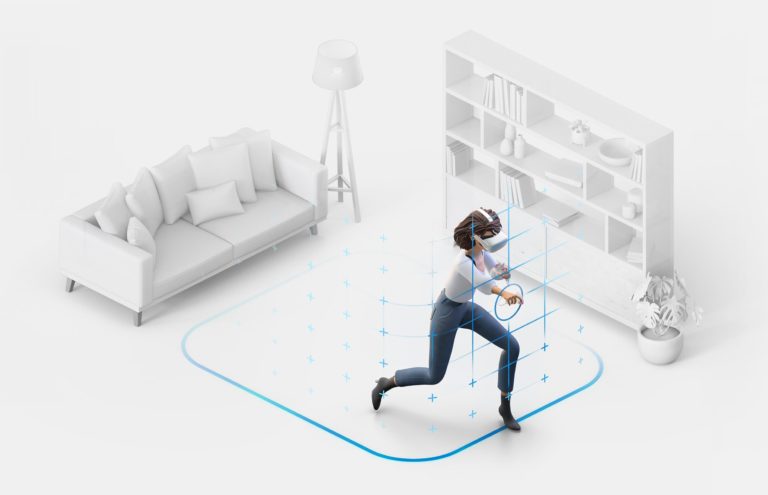
VR has come a long way. It has evolved from massive rigs that take up half a room to sleek and affordable headsets from Meta, HTC and others. The UX has likewise transformed from simple simulated environments to highly immersive experiences with six degrees of freedom. You’ve probably seen how VR is used in gaming, education, and remote work, offering a glimpse into its potential.
Meanwhile, 5G promises ultra-fast speeds, low latency, and high bandwidth. It can revolutionize industries by enabling real-time data transfer and seamless connectivity. This means your VR experiences could become even more lifelike and responsive, making you feel like you’re part of the virtual environment.
The State of VR
Current VR technology offers incredibly immersive experiences that allow you to explore virtual worlds, engage in realistic gaming, and participate in virtual meetings. However, there are still limitations, such as occasional lag, limited field of view, and the need for high-end hardware.
Popular VR applications include gaming platforms, educational programs, and virtual tourism. In retail, VR makes waves by letting you virtually try on clothes, experiment with different hairstyles, and test eyeglasses. Connectivity is crucial here, as faster and more reliable connections can reduce lag and improve the overall realism and responsiveness of VR interactions.
The Promise of 5G
5G represents the latest advancement in mobile networks, boasting features like ultra-fast speeds, incredibly low latency, and the capacity to connect many devices simultaneously. Previous generations — like 4G and 3G — often struggle with congestion and slower speeds. Meanwhile, 5G operates on higher radio frequencies less cluttered with other wireless communication signals.
This allows it to transmit data much faster and more reliably. 5G’s potential to revolutionize various tech sectors is immense, especially in VR. With 5G, your VR experiences can become more seamless and immersive, with real-time interactions and higher resolution. It can also transform how you engage with virtual worlds.
What Are 5G Wearables?
5G-enabled wearables are the next frontier in wearable technology, designed to take full advantage of the capabilities of 5G networks. These devices — which include VR headsets and AR glasses — provide a more immersive and responsive experience.
In addition, they feature low latency — often less than one millisecond of delay — compared to the approximately 70 milliseconds you’d experience on a 4G network. This drastic reduction in latency means movements and interactions in your VR environment feel almost instantaneous, greatly enhancing realism and user engagement.
Some examples of 5G wearables are already making waves in the market. These devices leverage the high-speed data transfer and low latency of 5G to offer you a smoother and more connected virtual experience.
Additionally, industry leaders are exploring 5G-enabled AR glasses, promising more advanced features and applications. With these advancements, 5G wearables can transform how you interact with virtual and augmented realities, making them more accessible and exciting.
Enhancing VR with 5G Wearables
5G wearables can significantly improve your VR experiences by leveraging the immense speed and low latency of 5G networks, up to 100 times faster than 4G. This means you can enjoy incredibly smooth and responsive interactions in your virtual environments without the frustrating lag often accompanying current VR setups. It allows high-quality, real-time graphics and interactions, making your VR experience more lifelike and immersive.
For example, 5G wearables can transform multiplayer VR games by reducing latency and enabling real-time interactions with other players worldwide. In educational VR applications, you can experience virtual field trips or simulations with seamless transitions and high-resolution visuals.
Additionally, industries like healthcare can benefit from 5G VR wearables by enabling real-time remote surgeries and consultations with no perceptible delay. These enhancements improve the quality of your VR experiences and open up new possibilities for how VR can be usable in various fields.
Challenges and Limitations
Adopting 5G wearables comes with its own set of challenges. One primary concern is the potential health implications of 5G radiation exposure, which has sparked debates and ongoing research.
Additionally, the reliance on advanced technology means there is a risk of system failures that could disrupt your VR experiences. Privacy issues are also a significant challenge, as the increased data transfer speeds of 5G could lead to more severe data breaches if security measures aren’t robust.
As a consumer, you must stay informed about these risks and choose devices from reputable manufacturers, prioritizing security and health safety. For developers, ensuring robust security protocols and addressing health concerns is crucial. These steps will help make 5G wearables a mainstream reality and provide seamless and immersive VR experiences.
What Does Gorilla Tag’s One-Million Mark Say About VR Engagement?
The Future of VR with 5G Wearables
5G wearables hold tremendous potential to revolutionize your VR experiences, offering unparalleled speed, low latency, and enhanced immersion. Stay curious and keep exploring 5G and VR technology advancements to appreciate and benefit from these innovations.
 April Miller is a senior writer at ReHack Magazine and editorial contributor at AR Insider. She specializes in VR/AR, IoT, and business technology. See her work here and follow her @rehackmagazine.
April Miller is a senior writer at ReHack Magazine and editorial contributor at AR Insider. She specializes in VR/AR, IoT, and business technology. See her work here and follow her @rehackmagazine.

